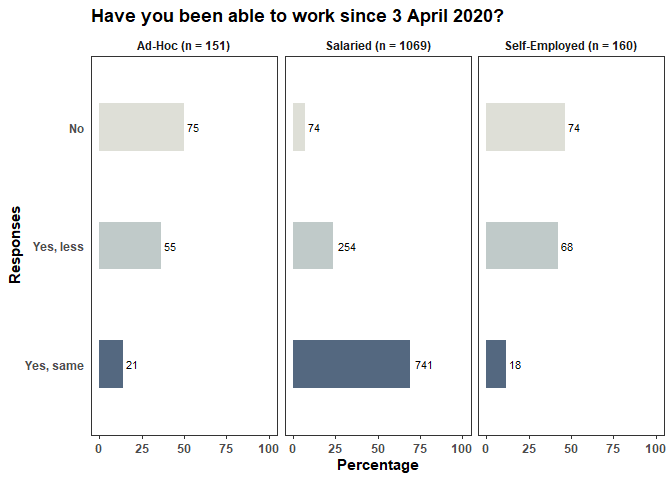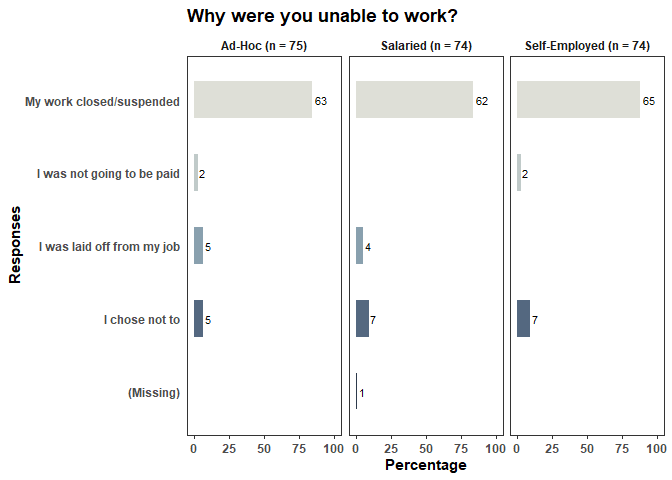We previously reported the impact of the ‘circuit breaker’ on contact patterns and visits to public places in Singapore based on our online survey through facebook advertisement between 9 and 14 April 2020. The circuit breaker is a month-long period of tightened distancing measures instituted by Singapore government to curb the spread of COVID-19 starting from 3 April 2020. You can find out more about the background, survey methodology, and demographic characteristics of respondents in the previous post.
Here, we analysed how the circuit breaker measures impacted work patterns and wage. In this analysis, we used data collected from 9 to 22 April 2020 (longer period compared to the previous post). We asked the following questions:
- Before 3 April 2020, when the government announced the new circuit breaker measures, were you doing paid work? Paid by the hour/by job; Paid by the day; Paid by the week; Salaried (paid a fixed salary each month); Self-employed
- Have you been able to work since 3rd April 2020? Yes, I have worked the same amount as usual; Yes, but less than usual; No
- If no, why not? I chose not to; I was not going to be paid; I was laid off from my job; My work closed/suspended
- Can your job be done remotely (e.g. working from home)? Yes, most of it can be done remotely; Yes, some of it can be done remotely; No
- Have you worked remotely since 3 April 2020? Yes, all the time; Yes, most of the time; Yes, some of the time; No
- Will you still get paid full wages? Yes; No
Ability to work since 3 April 2020
Prior to announcement of circuit breaker measures, 1395 out of 1924 (72.5%) respondents were doing paid work. Of these respondents, 151 (10.8%) were paid on an ad-hoc basis (i.e. paid by the hour, job, day, week), 1069 (76.6%) were salaried employees who were paid a fixed salary each month, 160 (11.5%) were self-employed, and 15 (1.1%) did not answer the question.
After the circuit breaker measures started, more than half of ad-hoc employees and self-employed reported that they have not been able to work while the work of the majority of salaried employees were not affected.

When circuit breaker measures were announced, 223 (16%) respondents reported that they have not been able to work. Among them, 75, 74, and 74 were ad-hoc, salaried employees, and self-employed, respectively. In all three employment types, most cited work closure or suspension as the reason.

Among the 1157 respondents who have been able to work either as usual or less than usual, most have been able to work remotely either all or some of the time. Higher proportion of ad-hoc employess reported that their work could not be done remotely, compared to salaried and self-employed.

Receiving wage by income
Among the 1157 respondents who have been able to work, the majority (88.1%) reported that they will receive full wage for their work.
However, when we assess whether the wage respondents will receive by household income after including those who have been unable to work since 3 April 2020, it paints a less rosy picture: higher proportion of respondents in lower income categories had to stop working and they will not get paid their full wage. The figure below shows the distribution of respondents across three questions:
- Have you been able to work since 3 April 2020?
- Can your job be done remotely?
- Will you get paid full wage?
The darker colour at the top of each panel represents the proportion of respondents who were unable to work since the circuit breaker measures were implemented. This proportion becomes smaller as household income increases. Similarly, approximately half of the respondents in the lowest income category reported that they will not receive full wage and this proportion diminishes with higher income.

Participation
We excluded respondents who reported not residing in Singapore (n = 12) and those younger than the age of 21, implausible or missing age (n = 40). The table below shows the demographic characteristics of the respondents.
| Overall (N=1924) | |
|---|---|
| Age in years | |
| Mean (SD) | 47.534 (11.747) |
| Range | 21.000 - 87.000 |
| Gender | |
| N-Miss | 2 |
| Male | 681 (35.4%) |
| Female | 1205 (62.7%) |
| Non-binary | 5 (0.3%) |
| Prefer not to say | 31 (1.6%) |
| Ethnicity | |
| N-Miss | 6 |
| Chinese | 1482 (77.3%) |
| Malay | 99 (5.2%) |
| Indian | 100 (5.2%) |
| Other | 184 (9.6%) |
| Prefer not to say | 53 (2.8%) |
| Education attainment | |
| N-Miss | 4 |
| No formal qualifications/lower primary | 0 (0.0%) |
| Primary (PSLE) | 10 (0.5%) |
| Secondary (O/N Level) | 236 (12.3%) |
| A Level/Polytechnic/Diploma | 417 (21.7%) |
| ITE/NTC | 40 (2.1%) |
| University | 1160 (60.4%) |
| Prefer not to say | 57 (3.0%) |
| Housing type | |
| 1-2 room HDB | 40 (2.1%) |
| 3-4 room HDB | 724 (37.6%) |
| 5-room HDB/executive flat | 505 (26.2%) |
| Private housing | 561 (29.2%) |
| Others | 38 (2.0%) |
| Do not know | 4 (0.2%) |
| Prefer not to say | 52 (2.7%) |
| Marital status | |
| N-Miss | 3 |
| Currently married | 1053 (54.8%) |
| Divorced | 117 (6.1%) |
| Never married | 606 (31.5%) |
| Separated but not divorced | 24 (1.2%) |
| Widowed | 19 (1.0%) |
| Prefer not to say | 102 (5.3%) |
| Household income | |
| N-Miss | 8 |
| < $2,000 | 169 (8.8%) |
| $2,000 - $3,999 | 262 (13.7%) |
| $4,000 - $5,999 | 277 (14.5%) |
| $6,000 - $10,000 | 389 (20.3%) |
| > $10,000 | 448 (23.4%) |
| Prefer not to say | 371 (19.4%) |